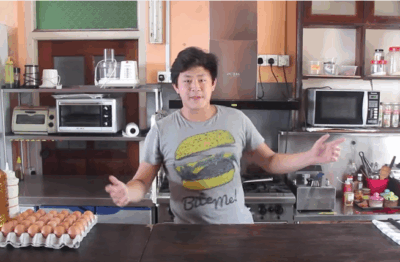Ahong’s blogpost
Double-Fried Ayam Goreng Kunyit
I grew up not knowing turmeric. I didn’t even know it was in all those legendary curries my mother used to make: her chicken curry left to intensify in the fridge, her masak hitam served with buttered bread. It was mad decadence. It was how I experienced my childhood.
My mother is worth at least a michelin star. Even today she wakes up around 4 am so as to arrive at the market before the rest of the herd. She would have a chat with her chicken supplier and inspect their prized corn fed chicken. These are not the butchers of the market who mainly sells defrosted chicken, but small farmers or amateurs who happen to rear some chicks. Once a beautiful bird is selected, my mother would hold it up high as if it was a great discovery. Then she’s off to find what’s best in the market and plan her menu around it. I now understand her enthusiasm, she grew up in a farm and they slaughtered their own poultry and planted their own vegetables. They ate fresh, organic and only what was in season because there was no other option.
I sometimes get caught up in nostalgia and struggle to live in the present. Cooking back then and now is very different mainly due to the pace of life in capitalist Malaysia. Going to the market everyday is only for the rich housewives or their maids. The average Joe probably doesn’t know how to slaughter a chicken or choose a ripe fruit. But that doesn’t mean we eat less well. We can now get food from anywhere imaginable to us. Be it a hamburger, sushi, french truffles or even soft serve ice cream shaped like a massive dildo from Korea.
I was lucky enough to study abroad for seven years. And it took me about 4 years to learn to navigate a world so foreign to me. As an outsider, I opened my eyes for the first time and saw how food is deeply rooted in culture. It is something nurtured over time and have practical relevance to its consumers. I often find myself most excited by common daily meals. A proper dirty fry-up with black pudding, pie and mushy peas, chips with vinegar, a big fat pasty, welsh lamb cawl, coronation sandwich or something as simple as apples with Stilton. For a few years I drowned myself in Britannia and felt closer to understanding them through the simple act of eating.
Once a Malaysian friend came to visit me in Cardiff and one of the girls made ayam goreng kunyit for lunch. Chicken, salt and turmeric powder quickly mixed and deep-fried. The chicken was fried to hell, but it was good. I ate it all including the bits of bones brittle due to over-frying. There it was, something from home in tangible form. It tasted good, but more importantly it opened a gate in my brain and flooded me with extreme emotion. I was deeply moved. My then-future-girlfriend was too. That has been the only fried chicken she liked since. Three ingredients and in wintery Cardiff, it was familiar yet new – it was an old memory experienced in a new context, much like van Gogh seeing that bright southern France sunlight.
So when I was asked to record myself cooking a dish using palm oil, ayam goreng kunyit came to mind. In Malaysia we eat a lot of fried stuff simple because it is too delicious and palm oil is partly responsible for this. It is relatively cheap, clean and has a smoking point of around 230°C. On average fried food is normally cooked around 180°C and when you deep-fry, you would need a lot of oil to minimize the temperature drop.
Spatchcock, brining, drying, double frying.
I decided to spatchcock a whole chicken so I can get it all done in a single fry, as opposed to frying the brown (thighs, drumsticks and wings) and white meat (breasts) separately as they require different treatment. By flattening out the chicken, the cooking time can be reduced and it doesn’t dry out that easily.
I then brined it in a salt and sugar solution for 24 hours before rubbing turmeric oil and drying the bird in a fridge for another 24-48 hours, much like how Chinese restaurants prepare their roasts.
After all that tedious process I deep-fried the chicken in palm oil at around 120°C for 15-20 minutes. The low temperature decreases the drying out and also avoids burnt meat. The best way to know when you are done cooking is to get a meat probe, or any thermometer than you can poke the chicken with. Now, if you’ve bought a really good chicken from a good butcher I would stop at 60°C. You would end up with a pink bone ala Hainan chicken rice and super moist meat. But for normal circumstances 70°C means it’s cooked and above 80°C the chicken is probably screwed.
Prior to the deep-frying, you can infuse the oil with herbs like curry leaves, serai or rosemary and garlic. But I find it only works well for huge quantities. I prefer to just flash fry the herbs until it’s crunchy and sprinkle it later on.
While the chicken is resting, the oil temperature was jacked up to around 200°C. When the oil is ready, I deep-fried the chicken again for another 3-4 minutes or as long as I dare to get that extra crunch. It was drained and set aside to rest for another 20 minutes.
This dish can be served with whatever dip you can think of: sambal belacan, hipster seaweed mayonnaise, kicap cili padi, cincaluk, or just ketchup. With a bowl of rice and some local vegetables, you have a sure winner. Until my nxt blogpost I’ll sign off with something you often hear in Malaysia:
“Ayam goreng kena ratah ramai-ramai baru sedap beb!”
About R.AGE Food Fight



















































Leave a reply